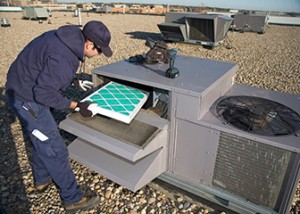Energy Efficiency Jobs
Refrigeration mechanics & installers are critical to the installation and maintenance of energy efficient refrigeration systems.
Refrigeration mechanics & installers are critical to the installation and maintenance of energy efficient refrigeration systems.
Refrigeration mechanics and installers sometimes can be combined with heating, air conditioning mechanics and installers. They are often referred to as HVACR technicians. These green job holders are among those that have a bright outlook in the going green environment with the increasing demand in energy efficient products. Refrigeration mechanics and installers work on installing, repairing and maintaining residential, industrial and commercial refrigeration systems, including, but not limited to household refrigerators and industrial freezers. Recent studies show that grocery stores spend more than 50 percent of their energy bills on refrigeration, therefore demand for energy efficiency refrigeration systems are very high.
Refrigeration mechanics and installers often need to observe and test refrigeration systems using gauges and instruments to verify the efficiency of these systems. These energy efficiency job holders rely on specifications to adjust valves and charge systems with proper type of refrigerant. They also read blueprints to determine location, size, capacity and type of components needed and to build energy efficient refrigeration systems. Refrigeration mechanics and installers use hand tools such as acetylene torches, wrenches and acetylene welding equipment to mount compressors, condensers, and other components in specified locations on frames or while installing expansion and control valves. The HVACR technicians use electrical, mechanical, and pneumatic testing equipment to test components of malfunction systems. The following are tools that refrigeration mechanics and installers may use in their green jobs:
 As part of their job, refrigeration mechanics and installers need to perform mechanical overhauls, recovery, recycling and reclaiming refrigerants. This task is especially important to the environment because some of them contain toxic chemicals. The release of refrigerants into the atmosphere can cause harmful effects to the environment such as depleting the ozone layer increasing the effects of global warming. With the going green movement, refrigeration mechanics and installers often need to replace older systems with newer ones that use safe and energy efficient refrigerants that are also earth-friendly and non-ozone depleting.
As part of their job, refrigeration mechanics and installers need to perform mechanical overhauls, recovery, recycling and reclaiming refrigerants. This task is especially important to the environment because some of them contain toxic chemicals. The release of refrigerants into the atmosphere can cause harmful effects to the environment such as depleting the ozone layer increasing the effects of global warming. With the going green movement, refrigeration mechanics and installers often need to replace older systems with newer ones that use safe and energy efficient refrigerants that are also earth-friendly and non-ozone depleting.
Green Job Summary
Work Environment for Refrigeration Mechanics and Installers
Refrigeration mechanics and installers usually work in residential homes, restaurants, grocery stores or other commercial buildings. They often need to work in cramped spaces where the refrigerating systems are located. Most refrigeration mechanics and installers have a 40-hour work week; some may have to work overtime when the demands are high.
Education, Training and Licensing
A Refrigeration mechanic and installer will usually enter this green career with training from vocational schools, related on-the-job experience or an associate’s degree. Previous work-related skill, knowledge, or experience is required for this job. With the increasing demands in energy efficiency refrigeration technologies, employers usually prefer applicants with three or four years of apprenticeship or several years of vocational training, and often must have passed a licensing exam. The following are recognized apprenticeable specialties associated with this occupation: Refrigeration Mechanic; Refrigeration/Air Conditioning Maintenance; Refrigeration Unit Repairer. Employees in this job typically require one or two years of training with other experienced workers as part of their on-the-job experience. This job usually involves using communication and organizational skills to coordinate, supervise, manage, or train others.
Employment Figures, Projections, Outlook and Earnings
The Bureau of Labor Statistics (BLS) indicates a bright outlook for heating, air conditioning, and refrigeration mechanics and installers. The BLS expects employment of this field to grow 29 percent from 2010 until 2020; this is much faster than the average for all jobs which is about 14 percent. The increasing in demand for trained technicians, especially in the green energy sector will result in excellent employment opportunities. The BLS projected 137,600 job openings between 2010 and 2020, and noted 267,800 refrigeration mechanics and installers jobs are currently filled. Job title examples are Refrigeration Mechanic, Refrigeration Technician, Service Technician, HVACR Technician, HVACR Service Technician, Refrigeration Operator, Transportation Refrigeration Technician, and Ammonia Refrigeration Technician. The BLS further reports that the median annual wage for salaried Refrigeration mechanics and installers was $42,530 in 2011 with median hourly wage of $20.45.